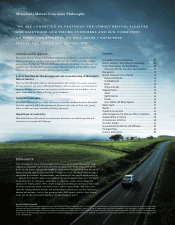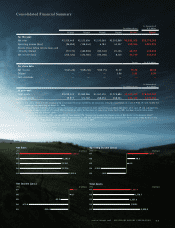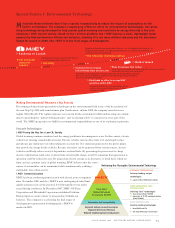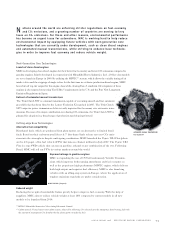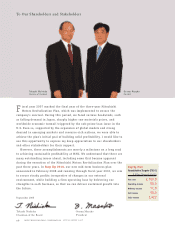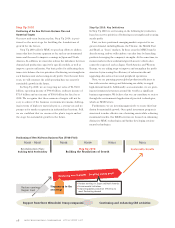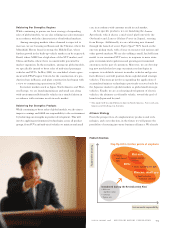Mitsubishi 2008 Annual Report Download - page 12
Download and view the complete annual report
Please find page 12 of the 2008 Mitsubishi annual report below. You can navigate through the pages in the report by either clicking on the pages listed below, or by using the keyword search tool below to find specific information within the annual report.
10 mitsubishi motors corporation annual report 2008
supply passenger and commercial-use minicars to Nissan Motor
Co., Ltd. on an OEM basis, and we plan to start supplying the
company with the mini SUV model
Pajero Mini
on an OEM
basis in autumn 2008. In addition, we have started to consider
cooperation with Nissan on the development and OEM supply
of small commercial vehicles built on a mini commercial vehi-
cle platform for the domestic and overseas markets, with an
emphasis on producing results in ASEAN and other Asian
nations. MMC started supplying PSA Peugeot Citroën (PSA)
with an SUV model in May 2007, and with this venture pro-
gressing steadily, we concluded a contract with PSA for local
production in Russia. Moreover, PSA and MMC have agreed to
consider collaborating in the area of electric vehicles. We will
continue to broadly search for win-win collaborations and alli-
ances on individual business ventures.
Sales Volume Target
MMC targets sales volume of 1,422,000 units in fiscal year
2010, an increase of approximately 5%, or 62,000 units, from
fiscal year 2007. Specifically, we are targeting steady increases
in sales volume in high-growth markets, such as Russia and the
Ukraine, and approximately 35% growth for the European
market as a whole, including the aforementioned nations. We
also see strong prospects for volume growth in resource-rich
nations in the Middle East, Latin America and elsewhere.
Boosting Global Production Efficiency
At the start of the Mitsubishi Motors Revitalization Plan, one of
the most important issues was overcapacity in production. By
fiscal year 2007, almost all of this overcapacity was eliminated.
Currently, our three plants in Japan and our production facility in
Thailand, which serves as an export base for one-ton pickup
trucks, continue to operate at high capacity utilization rates. To
make better use of overcapacity at our Netherlands Plant, we
transferred production of the
Outlander
for the European market
from the Okazaki Plant to that facility in August 2008, followed
by the shift of production of PSA-bound SUVs from the
Mizushima Plant, thereby opening up production capacity at our
domestic plants. With these moves, we aim to construct a pro-
duction system that is more efficient and better able to respond
to changes in demand for individual models, thereby avoiding
missed sales opportunities and maximizing profits.
Measures for Improving Profits
Measures to improve profits naturally include closer coopera-
tion among the development, production and sales divisions, as
well as stronger ties with members of the MMC Group, includ-
ing dealers and suppliers, and the pursuit of more improve-
ments on a global scale.
First, we are enhancing our logistics processes so as to elimi-
nate waste and to improve efficiency. We will do this by reducing
costs through more rigorous inventory management and by
upgrading functions for adjusting the supply-demand balance.
Second, we are working to expand profits in peripheral busi-
nesses, mainly in mature markets. Specifically, in Japan, because
the turnover period for new vehicles is becoming longer, we have
positioned policies aimed at strengthening ties with customers.
We will strengthen the sales companies’ marketing base by offer-
ing an increased number of products and service menus that
reflect customer needs. Finally, we have implemented programs
to reduce materials costs. Because of persistently high crude oil
prices, we must prepare for the risk of sharp increases in raw
materials costs and ensure stable procurement. We are therefore
working to establish a more robust procurement framework by
u
Better able to meet customer needs thanks
to procured technology and products
u Improved productivity including better
capacity utilization
u Cut costs (R&D expenses, fixed expenses,
equipment investment)
Alliance benefits
Reinforcing and Expanding Alliances
Current collaboration
Models supplied
Models procured
Components procured
Environmental technologies
Mitsubishi Heavy Industries
Yuasa and Mitsubishi Corporation
Models to supply
(Pajero Mini)
Models procured
(fall 2008 onwards)
(Nissan model name: AD/AD Expert)
Production
local production (start production in 2011)
Under consideration
vehicles based on minicar-class commercial
vehicles in Japan and overseas
Future
powertrains for electric vehicles
FY2008 and beyond


